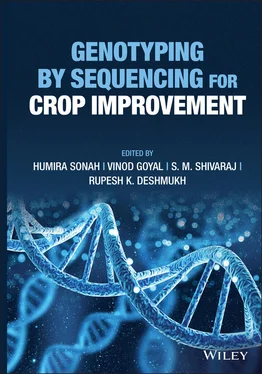Genotyping by Sequencing for Crop Improvement
Здесь есть возможность читать онлайн «Genotyping by Sequencing for Crop Improvement» — ознакомительный отрывок электронной книги совершенно бесплатно, а после прочтения отрывка купить полную версию. В некоторых случаях можно слушать аудио, скачать через торрент в формате fb2 и присутствует краткое содержание. Жанр: unrecognised, на английском языке. Описание произведения, (предисловие) а так же отзывы посетителей доступны на портале библиотеки ЛибКат.
- Название:Genotyping by Sequencing for Crop Improvement
- Автор:
- Жанр:
- Год:неизвестен
- ISBN:нет данных
- Рейтинг книги:4 / 5. Голосов: 1
-
Избранное:Добавить в избранное
- Отзывы:
-
Ваша оценка:
- 80
- 1
- 2
- 3
- 4
- 5
Genotyping by Sequencing for Crop Improvement: краткое содержание, описание и аннотация
Предлагаем к чтению аннотацию, описание, краткое содержание или предисловие (зависит от того, что написал сам автор книги «Genotyping by Sequencing for Crop Improvement»). Если вы не нашли необходимую информацию о книге — напишите в комментариях, мы постараемся отыскать её.
A thoroughly up-to-date exploration of genotyping-by-sequencing technologies and related methods in plant science Genotyping by Sequencing for Crop Improvement,
Genotyping by Sequencing for Crop Improvement
Genotyping by Sequencing for Crop Improvement
Genotyping by Sequencing for Crop Improvement — читать онлайн ознакомительный отрывок
Ниже представлен текст книги, разбитый по страницам. Система сохранения места последней прочитанной страницы, позволяет с удобством читать онлайн бесплатно книгу «Genotyping by Sequencing for Crop Improvement», без необходимости каждый раз заново искать на чём Вы остановились. Поставьте закладку, и сможете в любой момент перейти на страницу, на которой закончили чтение.
Интервал:
Закладка:
1.3.2 Polymerase Chain Reaction (PCR)‐based Markers
1.3.2.1 Simple‐Sequence Repeats (SSRs)
Simple‐sequence repeats (SSRs) (Litt and Luty 1989) are also known as microsatellites or short tandem repeats (STRs) or simple sequence length polymorphism (SSLP). These are widely used markers and are also referred to as the mother of all the markers. These are STRs, generally of one to eight nucleotide length. These are found dispersed throughout the genome and are hypervariable. These repeat regions are flanked with unique sequences that are highly conserved. The flanking unique sequences are used to design complementary primers which can be assayed with PCR. SSRs are highly polymorphic and codominant markers. These show polymorphism as a result of the variable number of repeat units. Before the era of genome sequencing, it was difficult to develop SSRs due to the extensive cost and labor involved in the identification of repeat regions and flanking unique sequences. However, with the availability of genome sequences of several organisms, the development of SSR has become very easy which involves in silico identification of STRs, designing of SSR from flanking unique sequences, and validation through experimentation. SSR markers have shown immense application in population genetic analysis, gene mapping, and cloning due to their abundance in the genome and high polymorphism, and very high reproducibility across labs. SSR‐based linkage maps have been developed in several important crop plants such as rice (Temnykh et al. 2000; McCouch et al. 2002; Orjuela et al. 2010), wheat (Roder et al. 1998), maize (Sharopova et al. 2002), potato (Milbourne et al. 1998), etc.
1.3.2.2 Sequence‐Tagged Sites (STSs)
Sequence‐tagged sites (STSs) were first developed for physical mapping of the human genome by Olsen et al. (1989). STS is the short unique sequences developed from polymorphic RFLP probe or AFLP fragment which is linked to desirable traits. The RFLP probes or AFLP fragments showing polymorphism are end‐sequenced and primers are designed to specifically amplify these fragments. STS markers are co‐dominant and highly reproducible. For example, STS markers have been developed for RFLP markers linked with bacterial blight resistance genes xa5, xa13, and Xa21 (Huang et al. 1997). One major limitation of these types of markers is the reduced polymorphism than the corresponding RFLP probe.
1.3.2.3 Randomly Amplified Polymorphic DNAs (RAPDs)
Williams et al. (1990) first developed these markers to amplify DNA without prior sequence information. In this type of marker, the arbitrary decamer sequences are used as primers at low annealing temperatures for DNA amplification. These markers are referred to as dominant markers because the polymorphism is determined based on the presence or absence of a particular amplified fragment. Polymorphism may also be due to varying brightness of bands at a particular locus due to copy number differences. These markers have been used for constructing linkage maps in several species (Hunt 1997; Laucou et al. 1998) and also for tagging genes of economic importance. However, due to the dominant nature, these may not be appropriate for genetic mapping and marker‐assisted selection (MAS). One major limitation of these markers is the lack of repeatability in certain cases. Variations of RAPD include AP‐PCR (arbitrarily primed PCR) and DAF (DNA amplification fingerprinting ( Table 1.1).
Table 1.1 Details of the other important molecular markers.
| Marker | Description |
|---|---|
| Variable number tandem repeat (VNTR) or minisatellites | A short DNA sequence (10–100 bp) is present as tandem repeats and is a highly variable copy number |
| DNA amplification fingerprinting (DAF) | A variation of RAPD, where 4–5 bp single and arbitrary primer is used to detect polymorphism |
| Arbitrary‐primed PCR (AP‐PCR) | A variation of RAPD, where 18–32 bp long single and arbitrary primer is used to detect polymorphism |
| Inter‐simple sequence repeat (ISSR) | Primers are designed based on the repeat region of microsatellites. These primers are used to amplify the region between two microsatellites. The stretches of unique DNA in between or flanking the SSRs are amplified. A single SSR‐based primer is used to prime PCR |
| Selective amplification of microsatellite polymorphic loci (SAMPL) | A modification of ISSR, where SSR‐based primer is used along with AFLP primer. The template is identical to the AFLP template and the rare cutter primer is replaced by SSR‐based primer |
| Cleaved amplified polymorphic sequences (CAPS) | These markers are also called PCR‐RFLP, where amplified PCR product is digested with endonucleases to reveal polymorphism. These are used when PCR product does not show polymorphism and restriction enzyme site present in amplified PCR product may detect polymorphism |
| Derived cleaved amplified polymorphic sequences (dCAPS) | A variation of CAPS, where a primer containing one or more mismatches to template DNA is used to create a restriction enzyme recognition site in one allele but not in another due to the presence of SNP. Thus, obtained PCR product is subjected to restriction enzyme digestion to find the presence or absence of the SNP |
| Single‐strand conformational polymorphism (SSCP) | DNA fragments of size ranging from 200 to 800 bp were amplified by PCR using specific primers (20–25 bp), followed by gel‐electrophoresis of single‐strand DNA to detect nucleotide sequence variation. The method is based on a principle that the secondary structure of single‐strand DNA molecule changes significantly if it harbors mutation. This method detects nucleotide variation without sequencing a DNA sample |
| Denaturing/temperature gradient gel electrophoresis (DGGE, TGGE) | These methods reveal polymorphism due to differential movement of the same genomic double‐stranded region with different base‐pair composition. As an example, the AT‐rich region would have a lower melting temperature than the GC‐rich region |
| Target region amplification polymorphism (TRAP) | This method employs primers designed from the EST database for detecting polymorphism around a selected candidate gene. This includes two primers of 18 bp, one of which is designed from targeted EST and the other is an arbitrary primer |
1.3.2.4 Sequence Characterized Amplified Regions (SCARs)
These markers overcome the limitation of RAPDs. In this case, the RAPD fragments that are linked to a gene of interest are cloned and sequenced. Based on the terminal sequences, longer primers (20 mer) are designed. These SCAR primers more specifically amplify a particular locus. These are similar to STS markers in design and application. The presence or absence of the band indicates variation in sequences. The SCAR markers thus are dominant in nature. These, however, can be converted to codominant markers in certain cases by digesting the amplified fragment with tetranucleotide recognizing restriction enzymes. There are several examples where the RAPD markers linked to the gene of importance have been converted to SCAR markers (Joshi et al. 1999; Liu et al. 1999; Kasai et al. 2000; Akkurt et al. 2007; Chao et al. 2018).
1.3.2.5 Amplified Fragment Length Polymorphism (AFLP)
This marker technique was developed by Vos et al. (1995) and is patented by Keygene ( www.keygene.com). In this technique, DNA is cut into fragments by a combination of restriction enzymes which are frequent (four bases) and rare (six bases) cutters that generate restriction overhangs on both sides of fragments. This is followed by the annealing of double‐stranded oligonucleotide adapters of a few oligonucleotide bases with respective restriction overhangs. The oligonucleotide adapters are designed in such a way that the original restriction sites are not reinstated and also provide the PCR amplification sites. The fragments are PCR amplified and visualized on agarose gel. This method produces many restriction fragments enabling the polymorphism detection. The number of amplified DNA fragments can be controlled by selecting different number or composition of bases in the adapters. The stringent reaction conditions used for primer annealing make this technique more reliable. This method is a combination of both RFLP and PCR techniques and is extremely useful in the detection of polymorphism between closely related genotypes. Like RAPD, AFLP is a dominant marker and is not preferred for genetic mapping studies and MAS. AFLP maps have been constructed in several species and integrated into already existing RFLP maps e.g. tomato (Haanstra et al. 1999), rice (Cho et al. 1997), and wheat (Lotti et al. 2000).
Читать дальшеИнтервал:
Закладка:
Похожие книги на «Genotyping by Sequencing for Crop Improvement»
Представляем Вашему вниманию похожие книги на «Genotyping by Sequencing for Crop Improvement» списком для выбора. Мы отобрали схожую по названию и смыслу литературу в надежде предоставить читателям больше вариантов отыскать новые, интересные, ещё непрочитанные произведения.
Обсуждение, отзывы о книге «Genotyping by Sequencing for Crop Improvement» и просто собственные мнения читателей. Оставьте ваши комментарии, напишите, что Вы думаете о произведении, его смысле или главных героях. Укажите что конкретно понравилось, а что нет, и почему Вы так считаете.












